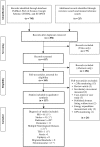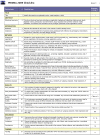Remote Physical Activity Monitoring in Neurological Disease: A Systematic Review
- PMID: 27124611
- PMCID: PMC4849800
- DOI: 10.1371/journal.pone.0154335
Remote Physical Activity Monitoring in Neurological Disease: A Systematic Review
Abstract
Objective: To perform a systematic review of studies using remote physical activity monitoring in neurological diseases, highlighting advances and determining gaps.
Methods: Studies were systematically identified in PubMed/MEDLINE, CINAHL and SCOPUS from January 2004 to December 2014 that monitored physical activity for ≥24 hours in adults with neurological diseases. Studies that measured only involuntary motor activity (tremor, seizures), energy expenditure or sleep were excluded. Feasibility, findings, and protocols were examined.
Results: 137 studies met inclusion criteria in multiple sclerosis (MS) (61 studies); stroke (41); Parkinson's Disease (PD) (20); dementia (11); traumatic brain injury (2) and ataxia (1). Physical activity levels measured by remote monitoring are consistently low in people with MS, stroke and dementia, and patterns of physical activity are altered in PD. In MS, decreased ambulatory activity assessed via remote monitoring is associated with greater disability and lower quality of life. In stroke, remote measures of upper limb function and ambulation are associated with functional recovery following rehabilitation and goal-directed interventions. In PD, remote monitoring may help to predict falls. In dementia, remote physical activity measures correlate with disease severity and can detect wandering.
Conclusions: These studies show that remote physical activity monitoring is feasible in neurological diseases, including in people with moderate to severe neurological disability. Remote monitoring can be a psychometrically sound and responsive way to assess physical activity in neurological disease. Further research is needed to ensure these tools provide meaningful information in the context of specific neurological disorders and patterns of neurological disability.
Conflict of interest statement
Figures


References
-
- Trost SG, Tudor-Locke C. Advances in the science of objective physical activity monitoring: 3rd International Conference on Ambulatory Monitoring of Physical Activity and Movement. British journal of sports medicine. 2014;48(13):1009–10. Epub 2014/06/13. 10.1136/bjsports-2014-093865 . - DOI - PubMed
-
- Van Remoortel H, Giavedoni S, Raste Y, Burtin C, Louvaris Z, Gimeno-Santos E, et al. Validity of activity monitors in health and chronic disease: a systematic review. The international journal of behavioral nutrition and physical activity. 2012;9:84 Epub 2012/07/11. 10.1186/1479-5868-9-84 ; PubMed Central PMCID: PMCPmc3464146. - DOI - PMC - PubMed
-
- Stansfield B, Clemes S, John D, Meijer K, Melanson E, Rowlands A, et al. 3rd International Conference on Ambulatory Monitoring of Physical Activity and Movement (University of Massachusetts, Amherst, USA, June 17–19, 2013). Physiological measurement. 2014;35(11):E2179–81. Epub 2014/10/24. 10.1088/0967-3334/35/11/2179 . - DOI - PubMed
-
- Strath SJ, Kaminsky LA, Ainsworth BE, Ekelund U, Freedson PS, Gary RA, et al. Guide to the assessment of physical activity: Clinical and research applications: a scientific statement from the American Heart Association. Circulation. 2013;128(20):2259–79. Epub 2013/10/16. 10.1161/01.cir.0000435708.67487.da . - DOI - PubMed
Publication types
MeSH terms
Grants and funding
LinkOut - more resources
Full Text Sources
Other Literature Sources
Medical
Miscellaneous

